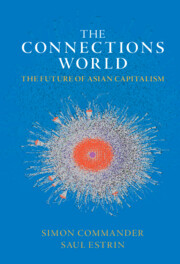Book contents
- The Connections World
- The Connections World
- Copyright page
- Dedication
- Contents
- Figures
- Colour Plates
- Tables
- Acknowledgements
- Abbreviations
- 1 The Strengths and Fallibilities of Asian Capitalism
- 2 To the Foothills of Everest
- 3 The Power of Networks of Connections
- 4 Networks, Connections and Business Organisation
- 5 What Scope for Innovation?
- 6 Employment in the Connections World
- 7 Whither Asia?
- References
- Index
4 - Networks, Connections and Business Organisation
Published online by Cambridge University Press: 11 October 2022
- The Connections World
- The Connections World
- Copyright page
- Dedication
- Contents
- Figures
- Colour Plates
- Tables
- Acknowledgements
- Abbreviations
- 1 The Strengths and Fallibilities of Asian Capitalism
- 2 To the Foothills of Everest
- 3 The Power of Networks of Connections
- 4 Networks, Connections and Business Organisation
- 5 What Scope for Innovation?
- 6 Employment in the Connections World
- 7 Whither Asia?
- References
- Index
Summary
Business groups are ubiquitous in Asia. They are networks of firms bound together through formal and informal family ownership. Some are massive; most are highly diversified, and they are often the dominant players in their home country. Business groups are a uniquely well-suited format for the connections world. Opaque cross-holdings and pyramids of stocks ensure that families can exert effective control, even if their actual shareholdings are relatively small, and provide opportunities for playing reciprocity games with politicians, civil servants and members of other oligarchic dynasties. Although there are examples of efficient and well-run business groups, most are not. Furthermore, while it has often been argued that business groups are a response to institutional and market weaknesses – for example in relation to securing finance – they have not faded with growth and the improvement in institutions. Rather, we show how business groups have become more entrenched in Asia over time and their revenues constitute a huge share of GDP. Such concentrated ownership has also had an impact on extreme wealth, with a staggering growth in the number of billionaires.
Keywords
- Type
- Chapter
- Information
- The Connections WorldThe Future of Asian Capitalism, pp. 116 - 154Publisher: Cambridge University PressPrint publication year: 2022



